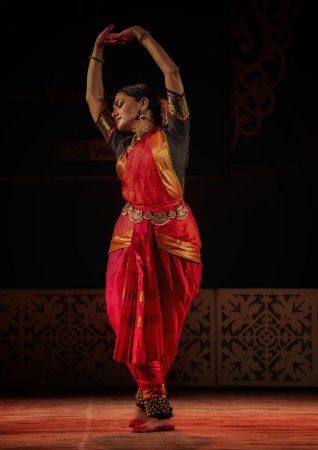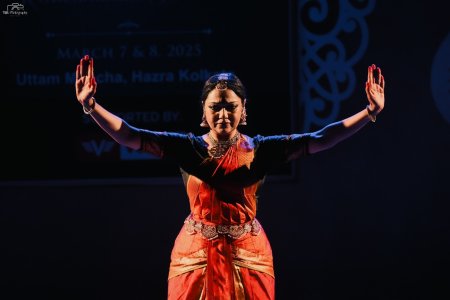
|   |

|   |
Jeevabastha by Rama Vaidyanathan - Debolina Ghosh e-mail: debolina.2009@rediffmail.com March 11, 2025 Rama Vaidyanathan offered Kolkata rasikas a bouquet on 7th of March at Mahanayak Uttam Mancha. Within a span of three items, she encompassed a vast range of our cultural diversity - starting from Guru Nanak's vision on human desire, then depth of love, passion and conjugality in our very own Rabindranath Tagore's song to puranic mysticism of Uchchista Chandalini.  Rama Vaidyanathan (Photo: Arijit Roy) The first presentation was based on Guru Nanak Dev's vision on human desire that causes cycle of innumerous births and deaths. The choreography was termed as Jeevabastha, according to which, there are ten stages or abasthas in our life. And each stage is hinged with indomitable desires. Some of the desires are very innocent but other desires make us a slave. It reminded one of what George Bernard Shaw wrote in his essay ‘Freedom' that slavery of man to nature is quite normal and innocent. Like in Pratham Abastha (1st stage) a newborn baby only wants milk. It is the only desire, innocent and natural. In Dwitiya Abastha (2nd stage), the toddler only wants his / her mother. Mother's lap, her proximity is the only desire of the toddler. Splendid eye expression beautifully explained the innocence and dependence of a child on the mother. In Tritiya Abastha (3rd stage), the toddler is now growing up. Children in this stage only want toys every day and are even dissatisfied with that. Toys of other children seem more attractive to them. In Chaturtha Abastha (4th stage), the children want social acceptance. They want to make friends and want to be accepted by all. In Pancham Abastha (5th stage), humans become fond of food and drinks. Relentlessly they eat and drink until they realise that it is telling upon their health. Rama showed the alarming heartbeats with the beats of mridangam - it was intense. In Shashtha Abastha (6th stage), one feels sexual desire that comes from within. The deep craving has been subtly woven in the choreography intertwined with sringara and lasya. In the Saptam Abastha (7th stage), we desire for money, fame and recognition and it does not have any limit. Inevitably, we get scarred again. Each stage is blemished and has scars as there is always a gap between wish and fact. So, in the Ashtam Abastha (8th stage), we want to get rid of all the hustles and bustles, moh-mayas. Inner peace is now the only desire. In Nabam Abastha (9th stage), we want to discard the ageing process. Total non acceptance to the reality makes us sad. It echoes the words of Percy Bysshe Shelley: We look before and after, And pine for what is not. The wrinkles, grey hair give us a shock. We gaze at our old photographs. We sadly yearn for our lost lustre. Each and every stage was so meticulously shown by Rama Vaidyanathan that one can still visualize the performance. In the final stage Dasham Abastha, we refuse to go with Yama - we don't want to die. When he comes riding on his bull to take us, we beg to be given a chance to drink the last drop of life but the last drop never becomes the last one, it is endless. Ironically, the embryo in the mother's womb does not want to take a new birth as in this stage it can remember all about the past life. In fear the embryo cries out: Nhi nhi manava janama punaha. This is based on Guru Nanak's vision of human desire from the Grantha Sahib. Rama wrote the script which was translated into Sanskrit by Divyanand Jha.  Rama Vaidyanathan (Photo: Rittik Photography) In Rama's second rendition of the trio, without any prelude or any introductory note the song started, O je mane na mana, a song of Prem Parjaay, a soul stirring, romantic love song of Rabindranath Tagore. A love relation between a man and a woman and their intimacy, passion have been endearingly rendered in the lyrics. Rama struck the right note with thoughtful choreography. The sringara, coyness of the nayika and her pride turn into happiness because of the respect and adoration she gets from her lover, warmly choreographed. Similarly, the mad pleading of the nayaka to his lady love to prolong the alluring enchantment was presented with a masculine ardency. At the end the dancer showed that the nayika pleasantly accepts her defeat by her lover. The final performance was based on goddess Uchchista Chandalini who can be found with grandeur in our ancient scriptures. She is an outcast, offered with left over food and used, dirty clothes. In that way she signifies reusability and recyclability. Through Uchchista Chandalini we can see how both sacred and profane, purity and impurity are included in Indian mythology. She embodies both lasya and fierceness. In a single movement of walking from back to the front of the stage, Rama nicely depicted the lasya and fierceness. The mysticism she created on the stage still resonates in our hearts. The captivating voice of Sudha Raghuraman was really enthralling. The stage was adorned by G Raghuraman on flute, S. Vasudevan on nattuvangam and Manohar Balatchandirane on mridangam. A big thanks to Ritachhanda Festival for offering us such a beautiful opportunity to witness this brilliant performance. SNB Foundation (Satyadev Narendranath Brahmachary Foundation) is an organisation based in Kolkata which endeavours to spread ancient Indian wisdom and knowledge among the young generation.  Debolina Ghosh is an MPhil scholar, Department of Sociology, University of Burdwan, West Bengal. |